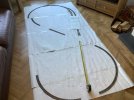jonte
Western Thunderer
Taking a break from the electrickery quagmire, thought I’d check out how a prospective additional crossover might pan out. Here drawn in luminous green felt tip on more lining paper and placed over the plan :

Hmm …’A good twenty inches’ as the actress said, it would be a bonus to operation, but whittle down train lengths considerably.
Ordinarily, the consequence wouldn’t be as drastic at a good six inches or so shorter, but of course, the Setrack gaps to facilitate smooth operation of trains on tight curves, rather stretches the construct out a tad. The only good point is that the generous platform lengths available as the plan stands - which in my book are a bit too dominating of the layout as a whole - would be brought to book, and as a bonus not make the station roof appear as ‘short’.
Now, as mentioned before, expected train lengths of only a loco and two carriages would still be on the table, although this would only be for the case for the two longer platforms ( the tape measure reads an available length of track of 3’ max), but unfortunately, the suburban service bays would be a little ‘too’ foreshortened. I could still operate a 2 car Bil, or so I reckon, but my venerable M7 push pull service might not be too enamoured with the arrangement.
Might have to leave be.
Who said this was fun
jonte

Hmm …’A good twenty inches’ as the actress said, it would be a bonus to operation, but whittle down train lengths considerably.
Ordinarily, the consequence wouldn’t be as drastic at a good six inches or so shorter, but of course, the Setrack gaps to facilitate smooth operation of trains on tight curves, rather stretches the construct out a tad. The only good point is that the generous platform lengths available as the plan stands - which in my book are a bit too dominating of the layout as a whole - would be brought to book, and as a bonus not make the station roof appear as ‘short’.
Now, as mentioned before, expected train lengths of only a loco and two carriages would still be on the table, although this would only be for the case for the two longer platforms ( the tape measure reads an available length of track of 3’ max), but unfortunately, the suburban service bays would be a little ‘too’ foreshortened. I could still operate a 2 car Bil, or so I reckon, but my venerable M7 push pull service might not be too enamoured with the arrangement.
Might have to leave be.
Who said this was fun

jonte










 )
) . However, I do maintain a 12v DC Analogue controller for testing and running in locos to ensure all is OK before installing DCC decoders.
. However, I do maintain a 12v DC Analogue controller for testing and running in locos to ensure all is OK before installing DCC decoders. - and a master switch will be required to switch between the DCC and 12v DC Analoge feeds. This starts to create an issue with the reverse loop........
- and a master switch will be required to switch between the DCC and 12v DC Analoge feeds. This starts to create an issue with the reverse loop........

 - which makes a migraine seem like a walk in the park.
- which makes a migraine seem like a walk in the park. )
)